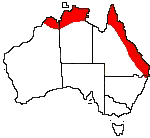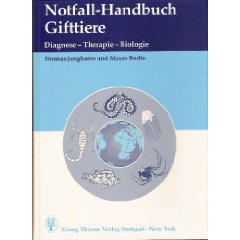|






| |
Oxyuranus scutellatus
Namen: Taipan; Common Taipan
Alte Namen:
- Oxyuranus scutellatus scutellatus
- Pseudechis scutellatus
- Pseudechis wilesmithii
- Oxyuranus scutellatus barringeri
Unterarten, Namen und Vorkommen:
Vorkommen: Süd-Papua Neu Guinea,
Indonesien (Irian Jaya), Australien (New South Wales, Northern Territory,
Queensland, Western Australia)

Beschreibung: Der Taipan ist die
größte Giftnatter Australiens. Die Kopf-Rumpf-Länge adulter Individuen aus
Australien beträgt bei Männchen 78,3-226,0 cm, bei Weibchen 101,4-193,0 cm, der
Schwanz erreicht 19-20 % der Kopf-Rumpf-Länge. Die Tiere sind schlank gebaut,
der Kopf ist groß, rechteckig und deutlich vom relativ schlanken Hals abgesetzt.
Die Geschlechter unterscheiden sich hinsichtlich Größe und Färbung nicht. Die
Grundfarbe der Oberseite ist variabel hellbraun, dunkelbraun, rotbraun,
kupferrot oder oliv. Tiere der Nominatform zeigen auf dieser Grundfarbe keine
Zeichnung. Der Kopf ist deutlich aufgehellt. Die Unterseite ist weißlich.
Der Kopf ist kaum vom Körper abzuheben. Bei
Oxyuranus scutellatus canni ist auf dem Rücken ein orangener Streifen
erkennbar. An den Seiten des Kopfes sind alle Tiere mit einer hellbeigen Färbung
versehen. Die Giftzähne erreichen eine Länge bis zu 12 mm. Die Tiere sind an
vielen Plätzen heimisch und nicht selten in der Nähe bewohnter Gebiete. Die
Schlange versucht bei einer Bedrohung immer zu fliehen. Falls dies nicht möglich
ist attackiert sie und beißt mehrmals hintereinander zu. Bei dem letzten Biss
hält das Tier sich an seinem Gegner fest und versucht durch Kaubewegungen mehr
Gift abzugeben.
Toxine:
Das Gift ist vor allem neurotoxisch, hat aber auch Komponenten, die die
Blutgerinnung stören. Das Neurotoxin blockiert praesynaptisch die
Signalübertragung auf die Muskulatur und verursacht so Lähmungen. Die
durchschnittliche Giftmenge je Biss wird mit 120 mg Trockengewicht angegeben.
Das Gift des Taipans ist extrem wirksam.
Symptome: Jeder Biss durch die
Schlange muss als lebensbedrohlich eingeschätzt werden. Es sind keine
Bissunfälle dokumentiert. Als allgemeine Zeichen können Kopfschmerzen, Übelkeit,
Erbrechen, Durchfall, abdominelle Schmerzen, Schwindel und Kreislaufstörungen
bis zum Kreislaufkollaps auftreten. An der Bissstelle kommt es zu lokalen
Schmerzen und Schwellungen. In den meisten Fällen wird es zu einer starken
neurotoxischen und gerinnungshemmenden Wirkung kommen. Ptosis, Blutgerinnungsstörungen
bis zur Ungerinnbarkeit des Blutes, Bewusstseinsstörungen bis Bewusstlosigkeit, Myoglobinurie,
Rhabdomyolyse, Nierenfunktionsstörungen bis akuten Nierenversagen. Vor allem
Kinder sind gefährdet.
Eine Fallbeschreibung finden Sie hier:
Biss von Oxyuranus scutellatus.
Maßnahmen:
Hier ist die
"pressure/ immobilization-technique"
anzuwenden. Bei Atemstörungen ist der Patient zu
intubieren und zu beatmen. Die weiteren Maßnahmen erfolgen symptomatisch. In der
Klinik kann eine Dialyse notwendig werden. Es existiert ein Antivenin. Dies ist
erst nach der Rücksprache mit einem Giftinformationszentrums zu geben.
Literatur:
-

-
The Reptile Database
-
WCH Clinical Toxinology
-
WCH Clinical Toxinology
- Taipane – Wikipedia
-
Toxikologische Abteilung, Klinikum Rechts der Isar, München
-
Distinct activities of novel neurotoxins from Australian venomous snakes for
nicotinic acetylcholine receptors.
-
The molecular basis of cross-reactivity in the Australian Snake Venom
Detection Kit (SVDK).
-
Identification and analysis of venom gland-specific genes from the coastal
taipan (Oxyuranus scutellatus) and related species.
-
Isolation and pharmacological characterization of cannitoxin, a presynaptic
neurotoxin from the venom of the Papuan Taipan (Oxyuranus scutellatus canni).
-
Full length nucleotide sequence of a factor V-like subunit of oscutarin from
Oxyuranus scutellatus scutellatus (coastal Taipan).
-
Proexosite-1-dependent recognition and activation of prothrombin by taipan
venom.
-
Isolation of subunits, alpha, beta and gamma of the complex taipoxin from the
venom of Australian taipan snake (Oxyuranus s. scutellatus)- characterization
of beta taipoxin as a potent mitogen.
-
The effects of antivenom on the in vitro neurotoxicity of venoms from the
taipans Oxyuranus scutellatus, Oxyuranus microlepidotus and Oxyuranus
scutellatus canni.
-
A pharmacological examination of venom from the Papuan taipan (Oxyuranus
scutellatus canni).
-
A novel small conductance Ca2+-activated K+ channel blocker from Oxyuranus
scutellatus taipan venom. Re-evaluation of taicatoxin as a selective Ca2+
channel probe.
-
Severe envenomation by the taipan (Oxyuranus scutellatus)
-
Electrocardiographic abnormalities in patients bitten by taipans (Oxyuranus
scutellatus canni) and other elapid snakes in Papua New Guinea.
-
Severe envenomation by the taipan (Oxyuranus scutellatus)
-
Differentiation between proteolytic activation and autocatalytic conversion of
human prothrombin. Activation of recombinant human prothrombin and recombinant
D419N-prothrombin by snake venoms from Echis carinatus and Oxyuranus
scutellatus.
-
Two novel alpha-neurotoxins isolated from the taipan snake, Oxyuranus
scutellatus, exhibit reduced affinity for nicotinic acetylcholine receptors in
brain and skeletal muscle.
-
Failure of 3,4-diaminopyridine and edrophonium to produce significant clinical
benefit in neurotoxicity following the bite of Papuan taipan (Oxyuranus
scutellatus canni).
-
Snake bites by the Papuan taipan (Oxyuranus scutellatus canni)- paralysis,
hemostatic and electrocardiographic abnormalities, and effects of antivenom.
-
The efficacy of antivenom in the treatment of bites by the Papuan taipan
(Oxyuranus scutellatus canni).
-
Coagulopathy following bites by the Papuan taipan (Oxyuranus scutellatus canni).
-
Deaths from snake bite in Australia, 1981-1991.
-
Activation of human factor VII by the prothrombin activator from the venom of
Oxyuranus scutellatus (Taipan snake).
-
An epidemiological study of snake bite envenomation in Papua New Guinea.
-
Prothrombin activation by an activator from the venom of Oxyuranus scutellatus
(Taipan snake).
-
Amino-acid sequence of the beta 1 isosubunit of taipoxin, an extremely potent
presynaptic neurotoxin from the Australian snake taipan (Oxyuranus s.
scutellatus).
-
Myotoxic activity of the crude venom and the principal neurotoxin, taipoxin,
of the Australian taipan, Oxyuranus scutellatus.
-
The taipan (Oxyuranus scutellatus) and the effect of its bite.
-
Oxyuranus (Taipan) - clinical pathology and pharmacology of venom
-
Schlangen- Neuguinea Taipan -- GORUMA
- Oxyuranus
scutellatus canni
-
Schlangen- Küstentaipan -- GORUMA
- North-west Taipan Oxyuranus
scutellatus barringeri subsp. nov.
-
MAVIN 2008-12-03, OXYURANUS SCUTELLATUS
|